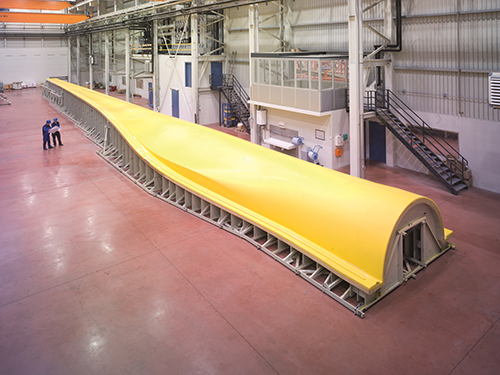This year for the first time, Schütz Composites, a branch of the global Schütz Group established in 1958, will be taking part in WindEnergy in Hamburg. This new branch of production draws on the experience in the making of special-purpose machines and tools gained over decades by the group’s internationally established divisions, packaging systems, energy systems and industrial services. The production – always hand in hand with the company’s ongoing in-house research and development – of lightweight materials and composite components under the brand name Cormaster, which the company has been supplying to the aerospace industry since the 1980s, has also been a key contributor. A further unique selling proposition is that Schütz develops and builds the operating technology for all of its product lines itself. Plant, machinery, moulds, production systems – all come from under the same roof. Access to the company’s extensive plant and machinery is guaranteed round the clock.
Schütz Composites is now successfully applying to the wind energy segment the know-how and extensive technical facilities the group has built up over decades. With its future-oriented approach, the division not only recognises the central role of wind energy as a viable solution in the changing energy market, but in doing so also subscribes to its parent company’s traditional maxim: to drive forward technological innovation in Germany – always autonomously, always in step with the times, and with respect for the environment.

In-house model and tool-making permits highly efficient workflows in all of these plants.
Schütz Composites’ range of activities and product portfolio fit perfectly into the exhibition concept of the international lead trade fair. They encompass research and development, the construction of master models, moulds and prototypes, and also the in-house production in Siershahn, Westerwald, of rotor blades for wind power plants. As a location, Siershahn is perfect, offering the necessary infrastructure for road and rail transport to and from the production plant.
In close collaboration with customers, the division’s engineers develop suitable solutions for the desired fields of application as a first step in the process. Based on the 3D geometries submitted, the desired design is then processed using special 3D CAD software. FEM analyses, mathematical proofs, production of the steel part in Schütz’ own metal works, and wood and plastic processing are all part of the division’s extensive portfolio. In all fields, the Schütz Composites team is also involved in collaborative research with universities and leading specialist institutes to optimise production processes and develop future materials.
The model-making department supplies the ideal solution for the application in hand, which is always developed in close collaboration with the customer. The close proximity of the model and tool-making units makes for highly efficient processes. A five-axis milling cell with simultaneously functioning gantries that make it suitable even for processing very large components is a great asset here. Such large components are designed in more than one section from the outset for easier transport to their final location, where the parts can then be aligned and assembled with the aid of laser scanners.
The tooling unit makes moulds for a wide range of products, from small RTM and injection-moulded parts just millimetres in size to large, 70-metre rotor blades. Smaller machine components are tooled direct in metal or plastic, while large components are produced from fibre-reinforced composites. The technologies used are vacuum infusion, VAP and laser projection, which, in combination with pre-cut fibre parts, permits fast and precise processing.
A large milling cell makes it possible for centrings, markings and positioning aids to be precisely machined onto the surface of tools. Also used in this process are modern dosing systems equipped with inline degassing and mix-ratio monitoring technologies. For heated tools, the customer can choose either an electrical or a water-heated system. Here, too, the high level of vertical integration throughout the Schütz Group means that it can produce high-precision components in-house that are absolutely fit for purpose down to the very last detail.
Schütz Composites is also ideally equipped for the production of rotor blades, which includes all processes from construction to handling and reworking. As the design and production of pre-cut fibre parts and aids take place within the company, a minimum of revision stages is necessary before the necessary kit is completed. At this point, efficient rotor blade production can begin. The required equipment for this includes high-grade mixing and dosing systems for laminating and adhesive resins, airless spray-painting systems and the company’s own pre-cut fibre parts. The five-axis milling centre also permits extremely flexible execution of blade flanges for prototypes and smaller serial productions. For larger series, Schütz Composites has a fast and highly flexible boring mill for diameters of up to 3500 millimetres. State-of-the-art QA and R&D systems are used in blade production – among others, thermal analysis of plastics, laser measurement technology and mechanical material inspection procedures.
All departments ensure the process reliability essential to an international build-to-print manufacturer working to the very highest standards: In quality gates, Schütz Composites conducts repeated tests to ensure the cure, vacuum-tightness and contour accuracy of its products meet maximum quality requirements.
Schütz Composites
www.schuetz-composites.net
Filed Under: News, Policy




